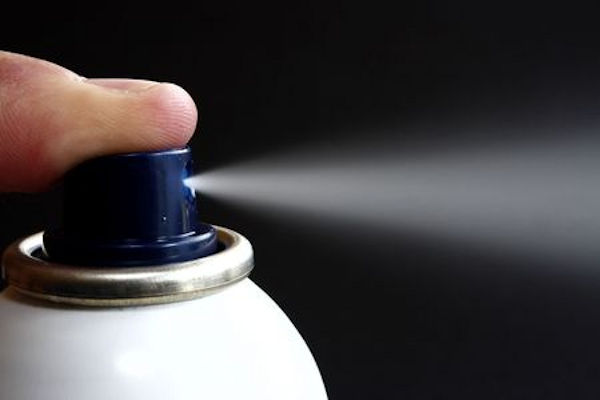Classes of Air Contaminants
Air contaminants are commonly classified as either particulate or gas and vapor contaminants. The most common particulate contaminants include dusts, fumes, mists, aerosols, and fibers.
Gases: Gases are formless fluids that naturally expand to fill any space or container they are in. Unlike solids or liquids, gases do not have a fixed shape or volume.
- Example: Carbon monoxide (CO) is a colorless, odorless gas that can build up in enclosed spaces where fuel is burned, such as in garages or poorly ventilated work areas with gas-powered equipment. Because it spreads to fill the space, workers may breathe it in without realizing it, leading to carbon monoxide poisoning.
Fumes: Fumes are tiny solid particles that form when a solid material is heated to a high temperature, becomes a vapor (volatilizes), and then condenses in cooler air. Most fumes are metal oxides because the vapor reacts with oxygen in the air during cooling.
- Example: When a welder uses an arc to melt metal (like steel), the metal vaporizes due to the intense heat. As this vapor cools in the surrounding air, it forms very fine particles—fumes—that often contain iron oxide or other metal oxides. Inhaling these fumes can cause health problems, including metal fume fever or long-term lung damage.
Liquids: Liquids are substances that have a definite volume but no fixed shape. They take the shape of their container. In the workplace, many liquids can evaporate, meaning they slowly change into vapors and mix with the surrounding air. This process happens more quickly at higher temperatures or with increased airflow.
- Example: Gasoline is a common liquid that evaporates easily. When gasoline is left open to the air—like during refueling—it releases flammable vapors. These vapors can mix with air and ignite if there's a spark or open flame nearby.

Mists: Mists are tiny liquid droplets suspended in the air. They form when a liquid condenses from a vapor back into tiny liquid particles (like steam turning into water droplets), or is mechanically dispersed into the air by actions like splashing, spraying, foaming, or atomizing.
- Example: A common workplace example of a mist is paint mist created during spray painting. When paint is sprayed, the liquid breaks into fine droplets that float in the air. These mists can be inhaled, exposing workers to harmful chemicals if proper controls, such as ventilation systems or respirators, are not used.
Aerosols: Aerosols are a type of mist made up of tiny liquid particles suspended in the air. These particles are so small that they can stay airborne for a long time and are easily inhaled deep into the lungs. Because of their size, aerosols are considered highly respirable, meaning they can enter the respiratory system and pose health risks, especially in poorly ventilated work areas.
- Example: A common workplace example of an aerosol is paint spray from a spray can. When a worker uses spray paint, it releases a fine mist of liquid particles into the air. These particles can be inhaled, potentially exposing the worker to harmful chemicals like solvents or heavy metals, depending on the paint type.
Vapors: Vapors are the gaseous form of substances that are usually liquids or solids at room temperature and pressure. Vapors are created when a solid or liquid evaporates—this can happen more quickly when heat is present or ventilation is poor.
- Example: Paint thinner gives off vapors as it evaporates. When a worker uses paint thinner to clean tools or surfaces, the liquid releases volatile organic compounds (VOCs) into the air. These vapors can be inhaled and may cause dizziness, headaches, or even organ damage with long-term exposure.
Dusts: Dusts are tiny solid particles created when solid organic or inorganic materials are broken down through mechanical processes. These processes include crushing, grinding, drilling, abrading, or blasting. Dusts can vary in size, and some are small enough to become airborne and inhaled, which may pose health risks depending on the material.
- Example: Silica dust is a common example in construction work. When workers cut, grind, or drill materials like concrete, brick, or stone, they generate fine dust particles that contain crystalline silica. Inhaling these particles over time can lead to silicosis, a serious lung disease, as well as an increased risk of lung cancer.
Fibers: Fibers are solid particles that are much longer than they are wide. To be considered a fiber, the length of the particle is typically at least three times its diameter. These particles can be natural or man-made and may pose health risks when inhaled, especially in occupational settings.
- Example: Asbestos fibers are a common workplace example. These fibers are released into the air when asbestos-containing materials are disturbed. They are long and thin—often invisible to the naked eye—and when inhaled, they can lodge in the lungs and cause diseases like asbestosis, lung cancer, or mesothelioma.
Knowledge Check Choose the best answer for the question.
2-2. Solid particles whose length is several times greater than their diameter are called _____.
You forgot to answer the question!

